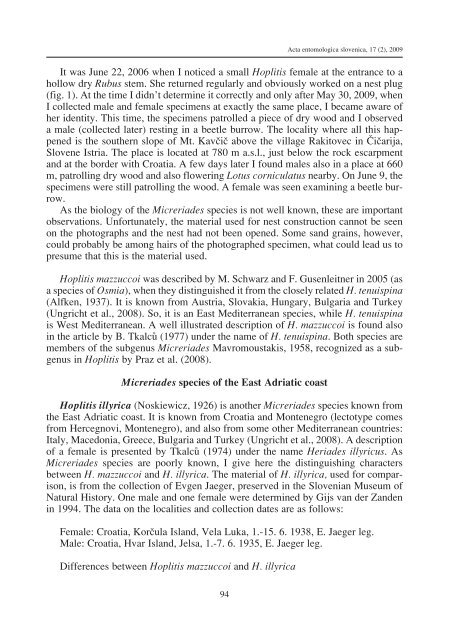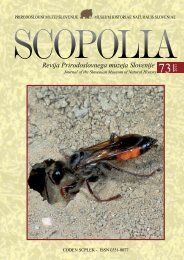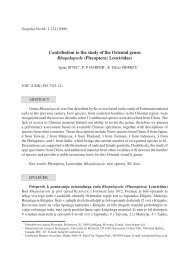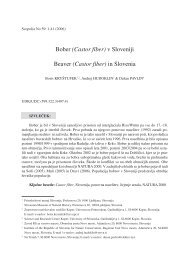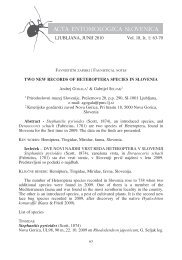Vsebina / Content (.pdf) - Prirodoslovni muzej Slovenije
Vsebina / Content (.pdf) - Prirodoslovni muzej Slovenije
Vsebina / Content (.pdf) - Prirodoslovni muzej Slovenije
You also want an ePaper? Increase the reach of your titles
YUMPU automatically turns print PDFs into web optimized ePapers that Google loves.
Acta entomologica slovenica, 17 (2), 2009<br />
It was June 22, 2006 when I noticed a small Hoplitis female at the entrance to a<br />
hollow dry Rubus stem. She returned regularly and obviously worked on a nest plug<br />
(fig. 1). At the time I didn’t determine it correctly and only after May 30, 2009, when<br />
I collected male and female specimens at exactly the same place, I became aware of<br />
her identity. This time, the specimens patrolled a piece of dry wood and I observed<br />
a male (collected later) resting in a beetle burrow. The locality where all this happened<br />
is the southern slope of Mt. Kavœiœ above the village Rakitovec in Œiœarija,<br />
Slovene Istria. The place is located at 780 m a.s.l., just below the rock escarpment<br />
and at the border with Croatia. A few days later I found males also in a place at 660<br />
m, patrolling dry wood and also flowering Lotus corniculatus nearby. On June 9, the<br />
specimens were still patrolling the wood. A female was seen examining a beetle burrow.<br />
As the biology of the Micreriades species is not well known, these are important<br />
observations. Unfortunately, the material used for nest construction cannot be seen<br />
on the photographs and the nest had not been opened. Some sand grains, however,<br />
could probably be among hairs of the photographed specimen, what could lead us to<br />
presume that this is the material used.<br />
Hoplitis mazzuccoi was described by M. Schwarz and F. Gusenleitner in 2005 (as<br />
a species of Osmia), when they distinguished it from the closely related H. tenuispina<br />
(Alfken, 1937). It is known from Austria, Slovakia, Hungary, Bulgaria and Turkey<br />
(Ungricht et al., 2008). So, it is an East Mediterranean species, while H. tenuispina<br />
is West Mediterranean. A well illustrated description of H. mazzuccoi is found also<br />
in the article by B. Tkalcu (1977) under the name of H. tenuispina. Both species are<br />
members of the subgenus Micreriades Mavromoustakis, 1958, recognized as a subgenus<br />
in Hoplitis by Praz et al. (2008).<br />
Micreriades species of the East Adriatic coast<br />
Hoplitis illyrica (Noskiewicz, 1926) is another Micreriades species known from<br />
the East Adriatic coast. It is known from Croatia and Montenegro (lectotype comes<br />
from Hercegnovi, Montenegro), and also from some other Mediterranean countries:<br />
Italy, Macedonia, Greece, Bulgaria and Turkey (Ungricht et al., 2008). A description<br />
of a female is presented by Tkalcu (1974) under the name Heriades illyricus. As<br />
Micreriades species are poorly known, I give here the distinguishing characters<br />
between H. mazzuccoi and H. illyrica. The material of H. illyrica, used for comparison,<br />
is from the collection of Evgen Jaeger, preserved in the Slovenian Museum of<br />
Natural History. One male and one female were determined by Gijs van der Zanden<br />
in 1994. The data on the localities and collection dates are as follows:<br />
Female: Croatia, Korœula Island, Vela Luka, 1.-15. 6. 1938, E. Jaeger leg.<br />
Male: Croatia, Hvar Island, Jelsa, 1.-7. 6. 1935, E. Jaeger leg.<br />
Differences between Hoplitis mazzuccoi and H. illyrica<br />
94


